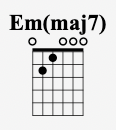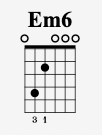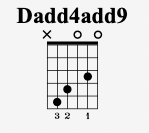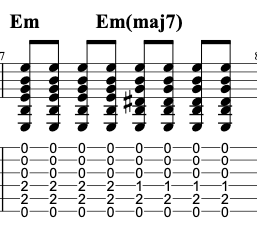Into The Great Wide Open Chords And Guitar Lesson (Tom Petty)
Behold the magnificent title track from the eighth studio album by American rock band Tom Petty and the Heartbreakers.
This album was the second album that Petty produced with the incredible Jeff Lynne.
I’m going to break it down for you step-by-step.
So grab your axe and let’s dive into this “Into The Great Wide Open" chords and guitar lesson!
Who Wrote Into The Great Wide Open?
"Into the Great Wide Open" was written by Tom Petty and Jeff Lynne, it’s the title track off the band’s 1991 album, Into the Great Wide Open. Lynne, who was a key figure in Petty's supergroup the Traveling Wilburys, co-wrote and produced the song.
The song’s lyrics sing a story about a guy named Eddie. He’s a young man with dreams of rock stardom and moves to Los Angeles. At first, he finds success, but as he rises, he loses his way, caught up in fame’s superficiality. The lyrics depict both the allure of the music industry and its inevitable letdowns.
The song was recorded at Sound City Studios in Van Nuys, California, with Lynne bringing his distinct production style. Mike Campbell, Petty’s longtime guitarist, also contributed significantly to the album’s sound. The opening slide part of this song is memorable and hits on an emotional level.
The music video, directed by Julien Temple, became iconic in its own right. Featuring Johnny Depp as Eddie, it’s almost like a mini-film, casting Faye Dunaway as his manager and Petty himself as the narrator.
This star-studded video further solidified its place in rock culture. Depp, then at the height of his early fame, brought a rebellious, relatable charm to Eddie’s character.
"Into the Great Wide Open" received positive reviews from critics, who praised Petty’s storytelling and the song's epic production.
Now, you may be wondering…
What is the tuning for Into The Great Wide Open?
The tuning for "Into The Great Wide Open", as recorded by Tom Petty is standard tuning. Petty and Campbell kept things simple.
Standard tuning for a guitar is spelled out as EADGBE.
Here are the strings:
- E (6th string, lowest pitch)
- A (5th string)
- D (4th string)
- G (3rd string)
- B (2nd string)
- E (1st string, highest pitch)
Next, let’s talk about the…
Into The Great Wide Open Chords
To play "Into The Great Wide Open" on guitar you only need to know these 13 main chords Em, Em(maj7), Em7, Em6, Am, C/G, F#m7b5, G, F, C, D, Dadd4add9, and A. Let’s take a look at a few options for how they might appear on the fretboard.
Em is played using all 6 strings like this:

Em(maj7) just changes one note from Em like this:

Em7 continues this pattern of only changing one note like this:

Em6 is also played using all 6 strings like this:

Those four chords create a minor descending pattern that is used in millions of songs. Then we have Am which is played from the 5th string down like this:

C/G looks like a typical C chord but the bass note is now playing the 5th of the chord (G) like this:

F#m7b5 (sometimes called F# half diminished) is played like this:

G is played in a folk/rock style like this:

F is a bar chord played in 1st position like this:

C is played from the 4th string down like this:

D is played from the 4th string down like this:

Dad4add9 has a fancy name however it’s just a C chord shifted up 2 frets like this:

Finally, we have A which is played from the 5th string down like this:
If you’ve struggled to understand the fretboard and want to learn it faster and in the simplest way. Then get your hands on my free fretboard guide PDF right here now:
All right, now that you know the "Into The Great Wide Open" chords, let’s now talk about…
What key is Into The Great Wide Open in?
"Into The Great Wide Open" as recorded by Tom Petty is in the key of Em/G major. The Verse section is in an E minor tonality, while the Chorus section switches to G major.
Since these keys are the relative major and minor of each other, here’s a quick breakdown of how these chords function in G major.
- Em (E minor): This is the vi chord in G major, a minor chord naturally occurring in the key. It serves as a tonic minor, often evoking a more introspective or melancholic mood in contrast to the major tonic chord, G.
- Em(maj7) (E minor with a major 7): This is a variation on the vi chord, which adds a sense of tension and complexity. The major 7th (D#) is not in the key of G, so this chord can create a subtle colorized passing chord.
- Em7 (E minor 7): This is another vi chord variation. The added D note (the 7th) keeps it fully diatonic in G major and provides a softer, jazzier sound.
- Em6 (E minor 6): Another variation of the vi chord, Em6 adds the note C#, which also lies outside G major. This gives it a colorful sound. These 4 minor chords are used to create a very common descending minor cliche.
- Am (A minor): This is the ii chord, naturally occurring as a minor chord in G major. The ii chord often functions as a pre-dominant chord, meaning it typically leads into the V chord (D).
- C (C major): The IV chord in G major, C is sometimes called the subdominant chord and can serve as an alternative to the tonic (G) for variety.
- F#m7b5 (F# minor 7 flat 5): This is the viiø chord (a half-diminished chord), functioning as a leading-tone chord in G major.
- G (G major): The I chord and tonic in G major. It’s the harmonic "home base" and provides stability in the progression.
- F (F major): F major is not diatonic to G major, as the note F natural is not in the key. This borrowed ♭VII chord (from G Mixolydian) adds a unique color. It’s sometimes called the sub-tonic and is often used to give a bluesy or rock feel.
- D (D major): The V chord in G major, D is the primary dominant chord that naturally leads back to the tonic G, creating a strong sense of resolution.
- Dadd4add9 (D with added 4th and 9th): This is a D chord with added G (4th) and E (9th). The added 4 and 9 create a suspended, open feel, adding tension while still implying the V chord’s function. It often resolves to G or stays unresolved for a dreamy feel.
- A (A major): A major is a non-diatonic chord in G major, as it contains C#. This V of V chord (secondary dominant) creates a strong pull to D (the V chord of G major), introducing a tension that leads back into the home key.
That’s the theory, but remember knowing all this doesn’t mean a thing without a good…
Into The Great Wide Open Strumming Pattern And Groove
The main underlying groove for "Into The Great Wide Open'" is a driving 8th-note rock feel. Strumming 8th notes means dividing each beat of a 4/4 time signature into two equal parts.
To properly strum 8th notes, you need to understand how to count them within each measure. In a 4/4 time signature, each measure has four beats. When subdividing each beat into 8th notes, each beat is divided into two equal parts, giving us a total of eight 8th notes per measure.
To count 8th notes, you typically use the following syllables:
1 & 2 & 3 & 4 &
Here’s the breakdown:
1: The first 8th note (on the beat)
&: The second 8th note (off the beat)
When counting out loud, it sounds like:
"One and, Two and, Three and, Four and"
Here’s an example of an “Into The Great Wide Open” strumming pattern:

Conclusion
To wrap it up, “Into The Great Wide Open” is a stand-out tune from the beautiful collaborations of Tom Petty and Jeff Lynne. With brilliant production and masterful songwriting, this song is a great addition to any guitarist's setlist.
Keep practicing, and if you want to learn songs faster, better understand the fretboard, and not waste years spinning your wheels with guitar, grab my free fretboard guide PDF right here now:
Jon MacLennan
Like this blog post? Get Jon’s best guitar lessons straight to your inbox.
